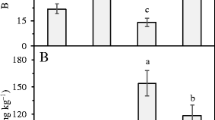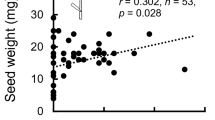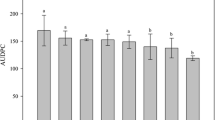Abstract
In two experiments young cabbage plants in the 4/6-leaf stage were supplied for eight weeks with nutrient solutions without nitrogen (oN), phosphorus (oP), calcium (oCa) or potassium (oK) in order to investigate the impact of withholding essential major elements on the development of black spot disease (Alternaria brassicicola) in intact leaves (variant Int) and detached leaf segments (variant Seg). A complete solution (Co) that contained all mineral elements essential for the growth of the host plant served as control. Lesion size in millimetres was measured as parameter of the pathogen activity. In the first trial, solutions oN, oP, oCa, and Co were tested simultaneously in four replications. Lesion size was estimated 5 days after inoculation (dai). In the second trial, only the solutions oK and Co were supplied in one replication and lesions were determined at 5 and 22 dai.
Supplying plants with the control solutions caused the largest leaf spots, whereas, with exception of the oP solution, the other ways of host nutrition significantly retarded disease development in the intact plants as well as in the segments compared with the control. The most drastic impact was caused by the oN (− 76 %) and oK (− 59.9 %) treatment in the Int variants. Whereas in both trials differences between the various nutrition treatments were significant at 5 dai, this could not be verified in the corresponding leaf segment variants in which the mean data obtained were significantly (about 38 %) lower than in the Int variant. Correlation analysis showed that there was no significant association between symptom expression caused by different nutrition in intact and detached host tissue when the data of each of the 5 dai treatment groups were included in the calculation, but when the data of all treatment series, including the 22 dai group in the second trial, were involved, a correlation coefficient of r = 0.61** could be calculated, indicating a relatively close association in affecting symptom expression between living and rapidly senescing host tissue. Symptom expression focussing on the impact of mineral elements, the putative relevance of some processes of the nitrogen and carbohydrate metabolism and of physiologic stress situations in the host as well as some special requirements in resistance studies deduced from the experimental results are the main objectives in the discussion.
Zusammenfassung
In zwei Versuchsdurchläufen wurden junge Kohlpflanzen im 4/6-Blatt-Stadium über acht Wochen mit Nährlösungen ohne Stickstoff (oN), Phosphor (oP), Calcium (oCa) oder Kalium (oK) versorgt, um den Einfluss des Entzugs von essentiellen Makroelementen auf die Entwicklung der Schwarzfleckigkeit (Alternaria brassicicola) auf intakten Blättern (Variante Int) und abgeschnittenen Blattsegmenten (Variante Seg) zu untersuchen. Eine komplette, alle für die Entwicklung der Wirtspflanze erforderlichen Mineralstoffe enthaltende Nährlösung fungierte als Kontrolle (Co). Als Parameter des Erregerwachstums diente die Läsionsgröße in Millimetern. Im ersten Versuch wurden die Lösungen oN, oP, oCa und Co simultan in vierfacher Wiederholung geprüft. Die Läsionsgrößen wurden am fünften Tag p. i. ermittelt. Im zweiten Versuch mit einer Wiederholung wurden nur die Nährlösungen oK und Co einbezogen und Kontrollen der Läsionsgrößen am fünften und 22. Tag p. i. vorgenommen.
Die größten Läsionen waren auf den Kontroll-Serien zu konstatieren, jedoch führten, mit Ausnahme der oP-Ernährung, alle anderen Ernährungsformen sowohl bei den Int- als auch Seg-Varianten zu statistisch signifikanten Restriktionen des Erregerwachstums im Vergleich zur Kontrolle. Den stärksten Einfluss hatten die oN-(− 76 %) und oK-(− 59.9 %) Behandlungen bei den intakten Pflanzen. Während sich in beiden Versuchsdurchläufen die Differenzen zwischen den verschiedenen Behandlungen am fünften Tag p. i. statistisch sichern ließen, war dies bei den Blattsegmenten, auf denen die ermittelten Läsionsgrößen signifikant geringer (im Durchschnitt 38 %) ausfielen als auf den entsprechenden Serien der Int Variante, nicht der Fall. In einer Korrelationsanalyse ergab sich kein signifikanter Zusammenhang zwischen der durch die unterschiedliche Wirtsernährung verursachten Symptom-manifestierung in intaktem und alterndem Wirtsgewebe, wenn die am fünften Tag p. i. erhobenen Daten für die Berechnung des Korrelationskoeffizienten zugrunde gelegt wurden. Wurden jedoch, bezogen auf die jeweiligen Behandlungsgruppen, die Kalkulationen über alle Daten einschließlich der am 22. Tag p. i. durchgeführt, ließ sich ein Korrelationskoeffizient von r = 0.61** schätzen, was auf einen relativ guten Zusammenhang der Symptomexpression auf intaktem und isoliertem Wirtsgewebe hindeutet. Der Einfluss von Mineralstoffen, die mögliche Bedeutung bestimmter Prozesse des Stickstoff- und Kohlenhydrat-Metabolismus und des physiologischen Stresses im Wirt auf die Symptommanifestierung sowie einige daraus ableitbare Vorgehensweisen bei praktischen Resistenzprüfungen sind Gegenstand der Diskussion.
Similar content being viewed by others
Literature
Anapurna, K., Jha, A. K., Sinha, S. K., Ojha, K. L. (1998): Effect of different sources of carbon, nitrogen and vitamins on the growth and sporulation of Alternaria brassicae (Berk.) Sacc. J. Appl. Biol. 8, 100–103.
Ansari, N. A., Khan, M. W., Muheet, A. (1989): Nutritional requirements of Alternaria brassicae for growth and sporulation. Ind. J. Plant Pathol. 7, 127–135 (Abstract).
Bergmann, W., Neubert, P. (1976): Pflanzendiagnose und Pflanzenanalyse. Gustav Fischer, Jena.
Bhedi, P. S., Dhiman, J. S. (1983): Influence of nitrogen and potassium on the development of early blight in tomato. Ind. Phytopathol. 36, 546–548.
Blachinski, D., Shtienberg, D., Dinoor, A., Kafkafi, U., Sujkowski, L. S., Zitter, T. A., Fry, W. E. (1996): Influence of foliar application of nitrogen and potassium on Alternaria diseases in potato, tomato and cotton. Phytoparasitica 24, 281–292.
Conn, K. L., Tewari, J. P. (1989): Interactions of Alternaria brassicae conidia with leaf epicuticular wax of canola. Mycol. Res. 93, 240–242.
Conner, R. L., Carefoot, J. M., Bole, J. B., Kozub, G. C. (1992): The effect of nitrogen fertilizer and irrigation of black point incidence in soft white spring wheat. Plant Soil 140, 41–47.
Dasgupta, B., Ghosh, R. K., Chatterjee, B. N. (1991): Effect of different dates and levels of nitrogen fertilizers on Alternaria blight disease and productivity of Indian mustard Brassica juncea L. Czern. and Coss. Environ. Ecol. 9, 118–123.
Domsch, K. H. (1957): Die Raps- und Kohlschotenschwärze. Z. Pflanzenkrankh. Pflanzensch. 64, 65–79.
Fuchs, W. H., Grossmann, F. (1972): Ernährung und Resistenz von Kulturpflanzen gegenüber Krankheitserregern und Schädlingen. In: Linser, H. (ed.): Handbuch der Pflanzenernährung und Düngung, vol. 1., part 2, pp. 1007–1107. Springer, Wien and New York.
Godika, S., Pathak, A. K., Jain, J. P. (2001): Integrated management of Alternaria blight (Alternaria brassicae) and white rust (Albugo candida) diseases of Indian mustard (Brassica juncea). Ind. J. Agric. Sci. 71, 733–735.
Hatcher, P. E., Ayres, P. G. (1998): The effect of fungal infection and nitrogen fertilization on the carbohydrate composition of Rumex obtusifolius leaves. Eur. J. Plant Pathol. 104, 553–559.
Hong, C. X., Fitt, B. D. L., Welham, S. J. (1996): Effects of wetness period and temperature on development of dark pod spot (Alternaria brassicae) on oilseed rape (Brassica napus). Plant Pathol. 45, 1077–1089.
Hossain, M. S., Mian, I. H. (2003): Physiological aspect of Alternaria brassicicola causing Alternaria blight of cabbage. Bangladesh J. Plant Pathol. 19, 7–11 (Abstract).
Huber, D. M. (1980): The Role of Nutrition in Defense. In: Horsfall, J. G., Cowling, E. B. (eds.): Plant Disease — An Advanced Treatise, vol. 5: How Plants Defend Themselves, pp. 381–405. Academic Press, New York.
Humpherson-jones, F. M., Maude, R. B. (1982): Studies on the epidemiology of Alternaria brassicicola in Brassica oleracea seed production crops. Ann. Appl. Biol. 100, 61–71.
Jennings, D. H. (1995): The Physiology of Fungal Nutrition. Cambridge University Press, Cambridge, United Kingdom.
Kadar, I., Marton, L., Horvath, S. (2000): Mineral fertilization of potato (Solanum tuberosum L.) on calcareous chernozem soil. Novenytermeles 49, 291–306.
Kennedy, R., Graham, A. M. (1995): Infection of oilseed rape by Alternaria brassicae under varying conditions of temperatures and wetness. Proceedings, 9th International Rapeseed Congress, 601–603.
Khatun, F., Hossain, M. A., Hossain, M. M., Dey, D. K. (1996): Effect of culture media, temperature, pH and nitrogen sources on growth and sporulation of Alternaria brassicicola. Bangladesh J. Plant Pathol. 12, 29–32 (Abstract).
King, S. R., Dickson, M. H. (1994): Identification of resistance to Alternaria brassicicola in Brassica oleracea. Cruciferae Newsl. 16, 126–127.
Köhle, H., Hoffmann, G. M. (1989): Untersuchungen zur Physiologie des Alternaria-Befalls von Raps. Z. Pflanzenkrankh. Pflanzensch. 96, 225–238.
Kurowski, T. P., Budzynski, W. (2003): The influence of differentiated nitrogen fertilization and insect control on sanitary state of spring oilseed rape. Rosliny Oleiste 24, 455–463.
Kurowski, T. P., Jankowski, K. (2003): The influence of fertilization on health status of white and Indian mustard. Rosliny Oleiste 24, 465–476.
Masclaux, C., Valadier, M. H., Brugière, N., Morot-Gaudry, J.-F., Hirel, B. (2000): Characterization of the sink/source transition in tobacco (Nicotiana tabacum L.) shoots in relation to nitrogen management and leaf senescence. Planta 211, 510–518.
Mengel, K. (1984): Ernährung und Stoffwechsel der Pflanze. Gustav Fischer, Jena, Germany.
Miflin, B. J., Lea, P. J. (1977): Amino acid metabolism. Annu. Rev. Plant Physiol. 28, 299–329.
Mothes, K. (1958): Ammoniakentgiftung und Aminogruppenvorrat. In: Ruhland, W. (ed.): Handbuch der Pflanzenphysiologie, vol. 8, pp. 716–762. Springer, Berlin, Göttingen and Heidelberg.
Mothes, K. (1960): Über das Altern der Blätter und die Möglichkeit ihrer Wiederverjüngung. Naturwissenschaften 47, 337–351.
Prell, H. H., Day, P. R. (2001): Plant-Fungal Pathogen Interaction — A Classical and Molecular View. Springer, Berlin and Heidelberg.
Rashid, A. Q. M. B., Meah, M. B., Jalaluddin, M., Razzak, A. H. M. (1988): Effect of fertilizer treatments on the incidence of leaf blights of wheat. Acta Phytopathol. Entomol. Hung. 23, 61–65.
Rotem, J. (1994): The Genus Alternaria — Biology, Epidemiology and Pathology. APS Press St. Paul, MN, USA.
Sadowski, C., Musnicki, C., Lemanczyk, G., Drozdowska, L., Trzcinska, E. (1998): Effect of different nitrogen fertilization and absence of pest control on health status of rapeseed. Bull. OILB/SROP 21, 221–226.
Sandhu, K. S., Hari, S., Kumar, R. (1985): Effect of different nitrogen levels and dates of planting on Alternaria blight and downy mildew diseases of radish seed crop. J. Res. Punjab Agric. Univ. 22, 285–290 (Abstract).
Sarkar, B., Gupta, P. K. S. (1978): Studies on some aspects of the epidemiology of Alternaria leaf blight of mustard (Brassica sp.). Beitr. Trop. Landw. Veterinärmed. 16, 91–96.
Scholze, P. (1994): Anfälligkeitsdisposition und -manifestierung bei Alternarien und Leptosphaeria in progenerativen Stadien von Gemüsebrassicaceen. Mitt. Biol. Bundesanst. 301, 116 (Abstract).
Scholze, P. (1995): Einführung eines Prüfverfahrens zur Recherche nach Resistenz gegen Alternaria und Phoma in progenerativen Stadien von Brassicaceen. Jahresbericht 1994, Bundesanstalt für Züchtungsforschung, Quedlinburg, Germany, 106.
Scholze, P. (2001): Zur Problematik der Alternaria-Resistenz bei Gemüse-Brassicaceen. Drittes Symposium Phytomedizin und Pflanzenschutz im Gartenbau, Vienna, Austria, 72–73.
Scholze, P. (2002): In-vitro-germinability of conidia and differences in aggressivity in Alternaria brassicicola-isolates on brassicaceous vegetables (Brassica oleracea L.). Pflanzenschutzberichte 60, 105–113.
Scholze, P., Hammer, K. (1999): Results of resistance evaluations in Brassicaceae with Plasmodiophora brassicae, Alternaria and Phoma lingam. In: Mugnozza, G. T. S., Pagnotta, M. A. (eds.): Genetics and Breeding for Crop Quality and Resistance, pp. 43–50. Kluwer, Dordrecht, The Netherlands.
Scholze, P., Krämer, R. (1997): Züchtung von gesundem Kohlgemüse. Forschungsreport. 1, 131–33.
Scholze, P., Krämer, R., Ryschka, U., Klocke, E. (1999): Searches of donors with resistance to Alternaria, Phoma, Plasmodiophora and turnip mosaic potyvirus (TuMV) in regenerates of protoplast fusion between resistant relatives of Brassicaceae and Brassica oleracea. Annual Report 1998, Federal Centre for Breeding Research, Quedlinburg, Germany, 192–193.
Scholze, P., Röver, V. (1989): Zum Einfluß von Mineralstoffernährung und Resistenz des Wirtes auf die Keimfähigkeit der Konidien des Gerstenmehltaus (Erysiphe graminis DC. f. sp. hordei March.). Arch. Phytopathol. Pflanzensch. 25, 145–153.
Schropp, W. (1951): Der Vegetationsversuch 1. Die Methodik der Wasserkultur höherer Pflanzen. Methodenbuch, vol. 8. Neumann, Radebeul, Germany.
Shah, S. F. A., McKenzie, B. A., Gaunt, R. E., Marshall, J. W., Frampton, C. M. (2004): Effect of early blight (Alternaria solani) and different nitrogen inputs on radiation interception, radiation use efficiency, and total dry matter production in potatoes (Solanum tuberosum) grown in Canterbury, New Zealand. N. Z. J. Crop Hortic. Sci. 32, 263–273, 2004.
Sharma, S. R., Singh, V. K., Kolte, S. S. (1994): Effect of macro- and micro-nutrients on the growth of Alternaria brassicae (Berk.) Sacc. on culture media. Ann. Plant Protect. Sci. 2, 72–75.
Sharma, J. P, Kumar, S. (1998): Effect of nitrogen on development of Alternaria blight caused by Alternaria solani of tomato (Lycopersicon esculentum) in rainy and winter seasons. Ind. J. Agric. Sci. 68, 110–113.
Singh, D. N., Singh, N. K., Srivastava, S. (1999): Biochemical and morphological characters in relation to Alternaria blight in rapeseed-mustard. Ann. Agric. Res. 20, 472–477.
Singh, D. P. (2004): The effect of inorganic fertilizers and weather parameters on Alternaria blight of rapeseed-mustard under screen house conditions. Ann. Agri-Bio Res. 9, 229–234.
Singh, B. P., Singh, S. P., Mohammad, A., Sinha, P. P. (1992): Effect of nitrogen, phosphorus and potash on the development of Alternaria leaf spot of cabbage. Ind. Phytopathol. 45, 245–247.
Söchting, H. P., Verreet J.-A. (2004): Effects of different cultivation systems (soil management and nitrogen fertilization) on the epidemics of fungal diseases in oilseed rape (Brassica napus L. var. napus). Z. Pflanzenkrankh. Pflanzensch. 111, 1–29.
Stankova, J. (1972): Varietal variability of winter rape with regard to its inclination to dark leaf spot and the factors influencing the development of this disease. Rostl. Vyr. 18, 625–630.
Strasburger, E. (1998): Lehrbuch der Botanik, 34th edition. Gustav Fischer, Stuttgart and New York.
Taber, R. A., Vanterpool, T. C., Taber, W. A. (1968): A comparative nutritional study of Alternaria raphani, A. brassicae, and A. brassicicola with special reference to A. raphani. Phytopathology 58, 609–616.
Turgeon, R. (1989): The sink-source transition in leaves. Annu. Rev. Plant Physiol. Plant Mol. Biol. 40, 119–138.
Verma, P. R., Saharan, G. S. (1994): Monograph on Alternaria Diseases of Crucifers. Saskatoon Research Centre, Saskatchewan, Canada.
Wagner, S. (2002): Einfluß obligat biotropher (Uromyces appendiculatus, Puccinia striiformis) und perthotropher Pilze (Botrytis cinerea, Drechsleria spec.) auf den Primärstoffwechsel ihrer mono- und dikotylen Wirtspflanzen (Phaseolus vulgaris, Triticum aestivum). Ph. D. thesis, Technical University of Braunschweig.
White, J. M., Strandberg, J. O., Brown, R. L. (1983): Influence of fertilizer on Alternaria leaf blight and yield of carrots grown in muck. Proceedings, Soil and Crop Science Society of Florida 42, 153–157.
Williams, P. H., Delwiche, P. A. (1979): Screening for resistance to blackleg in crucifers in the seedling stage. Proceedings, EUCARPIA Conference on the Breeding of Cruciferous Crops, 164–170.
Yarwood, C. E. (1959): Predisposition. In: Horsfall, J. G., Dimond, A. E. (eds.): Plant Pathology — An Advanced Treatise, pp. 521–562. Academic Press, New York.
Author information
Authors and Affiliations
Corresponding author
Rights and permissions
About this article
Cite this article
Scholze, P., Ding, Y. Manifestation of black spot disease (Alternaria brassicicola) in intact leaves and detached leaf segments of cabbage plants grown in nutrient solutions without N, P, K and Ca. J Plant Dis Prot 112, 562–572 (2005). https://doi.org/10.1007/BF03356153
Received:
Accepted:
Published:
Issue Date:
DOI: https://doi.org/10.1007/BF03356153
Key words
- Alternaria brassicicola
- cabbage
- major elements
- mineral deficiency
- nutrient solution
- physiological stress
- symptom expression




